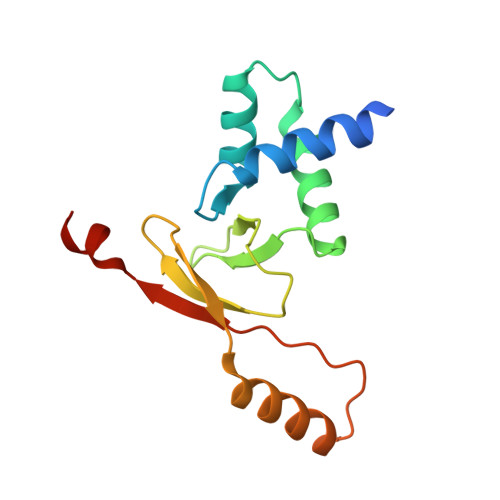Graded expression of zinc-responsive genes through two regulatory zinc-binding sites in Zur
Shin, J.-H., Jung, H.J., An, Y.J., Cho, Y.-B., Cha, S.-S., Roe, J.-H.(2011) Proc Natl Acad Sci U S A 108: 5045-5050
- PubMed: 21383173
- DOI: https://doi.org/10.1073/pnas.1017744108
- Primary Citation of Related Structures:
3MWM - PubMed Abstract:
Zinc is one of the essential transition metals in cells. Excess or lack of zinc is detrimental, and cells exploit highly sensitive zinc-binding regulators to achieve homeostasis. In this article, we present a crystal structure of active Zur from Streptomyces coelicolor with three zinc-binding sites (C-, M-, and D-sites). Mutations of the three sites differentially affected sporulation and transcription of target genes, such that C- and M-site mutations inhibited sporulation and derepressed all target genes examined, whereas D-site mutations did not affect sporulation and derepressed only a sensitive gene. Biochemical and spectroscopic analyses of representative metal site mutants revealed that the C-site serves a structural role, whereas the M- and D-sites regulate DNA-binding activity as an on-off switch and a fine-tuner, respectively. Consistent with differential effect of mutations on target genes, zinc chelation by TPEN derepressed some genes (znuA, rpmF2) more sensitively than others (rpmG2, SCO7682) in vivo. Similar pattern of TPEN-sensitivity was observed for Zur-DNA complexes formed on different promoters in vitro. The sensitive promoters bound Zur with lower affinity than the less sensitive ones. EDTA-treated apo-Zur gained its DNA binding activity at different concentrations of added zinc for the two promoter groups, corresponding to free zinc concentrations of 4.5×10(-16) M and 7.9×10(-16) M for the less sensitive and sensitive promoters, respectively. The graded expression of target genes is a clever outcome of subtly modulating Zur-DNA binding affinities in response to zinc availability. It enables bacteria to detect metal depletion with improved sensitivity and optimize gene-expression pattern.
Organizational Affiliation:
Laboratory of Molecular Microbiology, School of Biological Sciences, and Institute of Microbiology, Seoul National University, Seoul 151-742, Republic of Korea.















